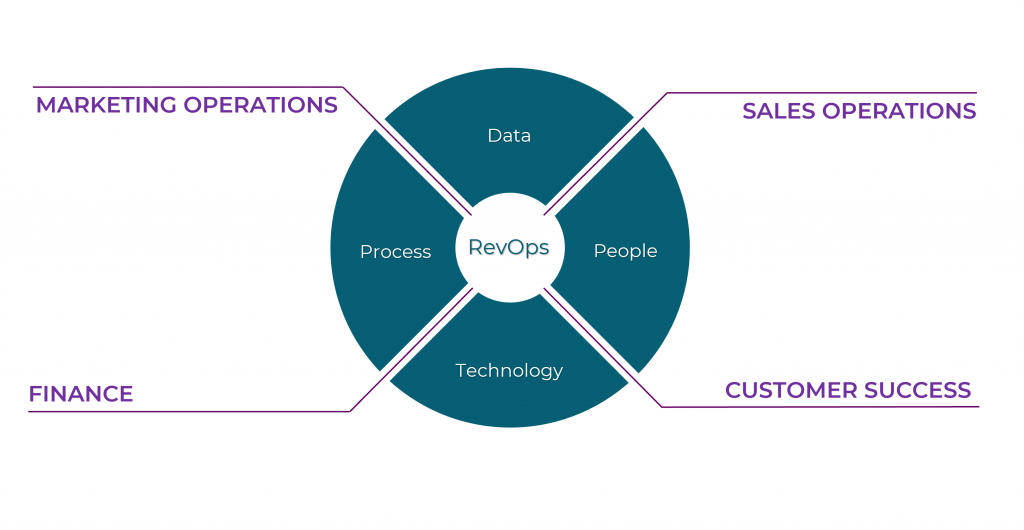The natural evolution of Marketing as custodian of Revenue Operations (RevOps)
When I started in B2B marketing 25 years ago, the function had two roles; build the brand and generate demand. That was pretty much it. Often (unkindly) referred to by sales colleagues as ‘colouring in’ and ‘running events’.
Of course, marketing has always been much more than that, but it’s been a constant battle for marketing to get recognition at the top table as not just a value creator, but an essential executive function. According to the 2024 Spencer Stuart CMO Tenure Study, nearly 30% of Fortune 500 companies still do not include a CMO in their top leadership team.
So, if only 70 percent of companies have a CMO, why should marketing be the best custodian of RevOps? Well, let’s start by defining RevOps before making the case for the most appropriate home.
RevOps as a critical function
Revenue Operations (RevOps) to give its full name, is in itself a relatively new concept. The primary goal of RevOps is to align and optimize the functions of sales, marketing, and customer service to drive consistent and predictable revenue growth. By breaking down silos between these teams, using the same tools, and following the same plan, a business should be able to maximize their revenue potential while reducing operational friction and increasing overall profitability.

According to Spencer Stuart, RevOps become a ‘thing’ and started gaining traction in around 2018. While the concept of aligning sales, marketing, and customer service isn’t entirely new, RevOps as a formalized strategy emerged more recently due to the increasing complexity of B2B sales processes and the growing importance of data and technology. It became especially popular in discussions among business leaders within the SaaS (Software as a Service) industry, where the need for such alignment was particularly acute.
As such a new concept, it’s unlikely anytime soon that most companies will have a RevOps leader, let alone a full function dedicated to the practice of identifying potential revenue, bringing it in effectively, and making sure it continues to come in and turn into cash consistently. Especially given well established marketing, sales, customer service, and even finance functions already having part of the responsibility.
The case for sales or the ‘chief revenue officer’
You hear ‘revenue’ and you immediately think sales, right? There’s a good case to think sales leaders are well placed to own RevOps. They’re the team most closely targeted with (and compensated on) bring in revenue. But their remit can be narrow. Often relying on marketing to show them where the potential revenue is, finance to collect it, and customer services to keep clients happy enough that it keeps coming in long into the future.
Also, given the high-pressure, performance-based nature of B2B selling, the average tenure of salespeople is relatively short. According to MarketingSherpa, the average tenure for B2B salespeople is around 18 months to 2 years. On the other hand, B2B marketing professionals generally stay in their roles longer, with an average tenure closer to 2.5 to 3 years. This can potentially cause disruption to the RevOps motion and creates a short-term focus at odds with the overall mission.
What about Customer Service (or Finance)
For sure, there is a strong correlation between happy clients, and ongoing revenue generation from them. Customer Service (and Finance) are rightly in the detailed mechanics of making sure services or products are delivered, and therefore invoices issued and cash received. Which is great for the current roster of clients. But what about those companies that aren’t yet clients, to those companies that may be clients but have yet to be converted – that happens way before Customer Service and Finance get involved.
The case for marketing and the CMO
Consider for a moment the typical challenges faced by the CMO and their marketing function. Demonstrating ROI from finite marketing budgets is most likely to top of the list. It’s pretty easy to spend money on demand generation or performance marketing and measure the creation of leads and conversion of deals. Somewhat more difficult to spend money on brand and relate to an inflow of new, valuable business.
But the key challenge in all of this is not the generation of demand. It’s the closure of business and receipt of cash that marketing leaders and CMOs increasingly worry about. That’s why we see marketing caring about the enablement of B2B sales teams – are they on message, well equipped to close the leads you pass to them. It’s why marketing often owns the CRM (not just the martech stack).
It is in marketing’s interest to ensure that every lead generated is follow-up with the best chance of conversion. Why every sales engagement needs to be ‘on brand’ to drive consistency and authenticity in how the company and products are positioned. And ultimately, it’s all too familiar when revenue is light for all eyes to turn to marketing and be asked to fix it – sure, with more, better qualified, ready-to-buy opportunities, but importantly better sales conversion, better opportunity management and insights, and better client experiences and net promoter scores (NPS).
If you’re interested in how marketing can step up and turn from colouring in and running events into an end-to-end revenue operations function, get in touch with Tayona Digital today.




